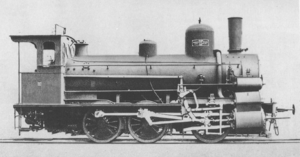Baden VII d
| Baden VII d | ||||
|---|---|---|---|---|
| Numbering: | 24 ... 732 | |||
| Number: | 2 | 16 | 41 | 30th |
| Manufacturer: | MBG Karlsruhe , Maffei , Esslingen machine works | |||
| Year of construction (s): | 1893 | 1894-1897 | 1898+ 1899 | 1901+ 1902 |
| Retirement: | until 1925 | |||
| Type : | Cn2v | |||
| Gauge : | 1435 mm | |||
| Length over buffers: | 14794 mm | 15597 mm | ||
| Height: | 4150 mm | |||
| Fixed wheelbase: | 3450 mm | |||
| Empty mass: | 38.3 t | |||
| Service mass: | 43.8 t | |||
| Friction mass: | 43.8 t | |||
| Wheel set mass : | 14.6 t | |||
| Top speed: | 45 km / h | |||
| Coupling wheel diameter: | 1262 mm | |||
| Control type : | Stephenson | Heusinger | ||
| Number of cylinders: | 2 | |||
| LP cylinder diameter: | 700 mm | 730 mm | ||
| HD cylinder diameter: | 500 mm | 490 mm | ||
| Piston stroke: | 635 mm | |||
| Boiler : | Belpaire | Crampton | ||
| Boiler overpressure: | 12.0 bar | |||
| Number of heating pipes: | 183 | |||
| Heating pipe length: | 4350 mm | 4000 mm | ||
| Grate area: | 1.45 m² | 1.62 m² | 1.72 m² | |
| Radiant heating surface: | 7.52 m² | |||
| Tubular heating surface: | 113.70 m², later 103.50 m² | |||
| Evaporation heating surface: | 121.22 m², later 111.52 m² | |||
| Locomotive brake: | Air brake type Westinghouse | |||
The vehicles of type VII d of the Grand Ducal Baden State Railroad were freight steam locomotives with two-cylinder compound engines .
After the last locomotives of classes VII a and VII c with single steam expansion were delivered in 1891 , the state railroad followed the general trend in 1893 and acquired locomotives with a composite effect. The construction was largely based on the previous machines.
The Maschinenbau-Gesellschaft Karlsruhe delivered a total of 59 locomotives in various series from 1893 to 1901. Maffei and Maschinenfabrik Esslingen delivered 34 and 16 machines respectively between 1898 and 1902. In the course of the individual delivery series there were some improvements and changes in the design.
If the locomotives initially took over the freight transport in the entire area of the Baden railway, their use soon shifted to the flat land routes. The locomotives were the heaviest German triple-coupled machines. The preliminary re-drawing plan of the Deutsche Reichsbahn from 1923 still contained 91 locomotives, as class 53.9 (deliveries from 1901) and 53.86. However, they were retired by 1925 because they were not suitable for use in shunting and local freight train service.
Constructive features
The locomotives had an internal sheet metal frame. The boiler of the first two locomotives from 1893 was designed as a Belpaire boiler with a steam dome on the third boiler section. For the following deliveries, however, they switched to a smooth Crampton type boiler. The large steam dome sat on the front boiler section. External inlet pipes led to the slightly inclined external cylinders. The high-pressure and low-pressure cylinders had the unusual ratio of 1: 2.4 to one another. The engine acted on the central coupling axle. The starting device for the locomotives built in 1893 and 1894 was based on the Gölsdorf design; later, interchangeable slides were used. The locomotives of the first series from 1893 still used an internal Stephenson control instead of the external Heusinger control used later.
In later versions, the grate area was increased, while the length of the heating pipes was reduced.
In the 1893 version, the front and middle axles were supported on the frame by means of leaf springs and the rear with a short twin spring on top. Starting with the next delivery series, all axles had long leaf springs underneath.
The Westinghouse air brake acted on the second and third coupled axles. The locomotives had a steam heater, a Nathan oiler and, from 1901, a Ritter type grease gun.
The vehicles were a Tender , but later equipped with class 2 T8 3 T13,5.
literature
- Hermann Lohr, Georg Thielmann: Baden locomotive archive . transpress, Berlin 1988, ISBN 3344002104
